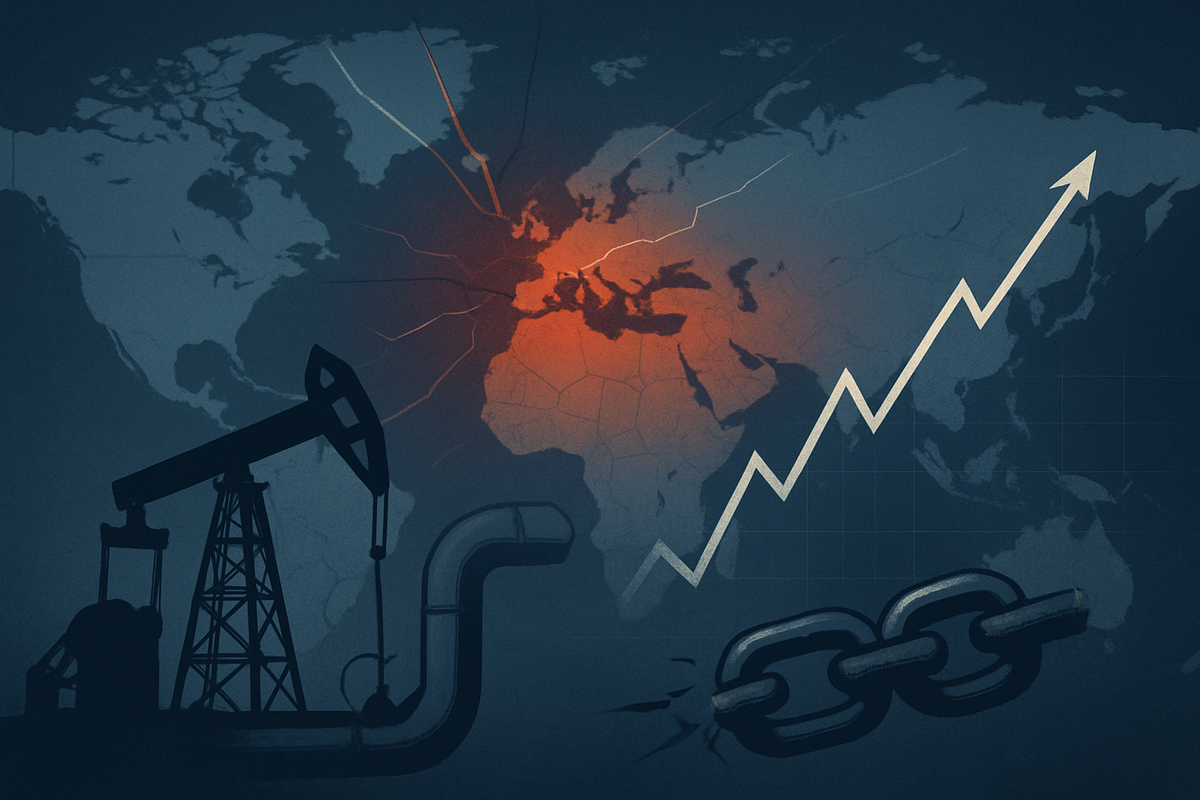
Global energy markets are once again grappling with the profound and often immediate impact of escalating geopolitical tensions and political instability in key producing regions. From the battlefields of Eastern Europe to the volatile corridors of the Middle East, the specter of conflict is casting a long shadow over the supply and pricing of essential commodities like oil and natural gas. This intricate dance between international politics and energy economics is creating significant volatility, pushing prices higher, and introducing a persistent "geopolitical risk premium" that reverberates through global economies and consumer pockets.
The current landscape, marked by a confluence of ongoing conflicts and emerging flashpoints, underscores the inherent fragility of the global energy supply chain. Any disruption, real or perceived, in critical chokepoints or major producing nations can trigger a chain reaction, leading to sharp price spikes, increased market uncertainty, and broader inflationary pressures. As of November 19, 2025, the market remains acutely sensitive to developments, with traders and analysts closely monitoring every shift in the geopolitical winds for clues on future energy trajectories.
Unpacking the Crisis: A Closer Look at Recent Disruptions and Market Responses
The past few years have offered stark reminders of how quickly geopolitical events can upend energy stability. The full-scale invasion of Ukraine by Russia in February 2022 stands as a monumental example, fundamentally reshaping global energy dynamics. Russia, a colossal player as the world's third-largest oil producer and a primary natural gas supplier to Europe, saw its energy exports become a geopolitical weapon and a target of international sanctions.
The immediate aftermath of the Russia-Ukraine War witnessed an unprecedented surge in energy prices. Brent crude oil and West Texas Intermediate (WTI) crude oil futures quickly surpassed $100 per barrel, with Brent (ICE: B) briefly hitting a seven-year high of $105.79 per barrel. This wasn't merely a fleeting spike; the conflict was found to account for over 70% of the fluctuation in these benchmark crude prices during the initial event window, amplifying volatility and fundamentally altering long-term price trends. Europe, heavily reliant on Russian natural gas via pipeline networks, faced a severe energy crisis, leading to soaring natural gas prices and widespread inflationary pressures across the continent. Western sanctions, while aiming to cripple Russia's war machine, inadvertently exacerbated global supply-demand imbalances, solidifying a substantial geopolitical risk premium in the market.
Simultaneously, the Middle East continues to be a perennial flashpoint, its vast oil reserves and strategic maritime chokepoints making it central to global energy security. The Israel-Hamas War, which erupted in October 2023, immediately rekindled fears of broader regional escalation. While neither Palestine nor Lebanon are major oil producers, the fear of the conflict spreading to key producers like Iran or impacting critical shipping lanes, particularly the Strait of Hormuz, caused Brent prices to rise by approximately 4% initially. The International Monetary Fund (IMF) has since warned that a significant escalation could lead to a 15% rise in oil prices, potentially adding 0.7% to global inflation. Furthermore, incidents such as attacks by Houthi forces in Yemen on merchant vessels in the Red Sea (2023-2024) have disrupted crucial shipping routes, increasing transportation costs and contributing to higher oil prices. Reports as recent as November 2025 have indicated renewed concerns over the security of the Strait of Hormuz, through which approximately 25% of the world's oil flows, further contributing to oil price surges. These events underscore how even localized conflicts can have outsized global energy market implications due to the interconnected nature of supply chains and the psychological impact on market sentiment.
Market Movers: Winners and Losers in a Volatile Energy Landscape
In a market defined by geopolitical volatility, certain public companies and sectors are poised to either significantly benefit or suffer. The direct beneficiaries are often major oil and gas producers, particularly those with diversified assets outside conflict zones or those capable of ramping up production to fill supply gaps. Companies like ExxonMobil (NYSE: XOM), Chevron (NYSE: CVX), and Shell plc (LSE: SHEL) often see their share prices climb during periods of high crude oil and natural gas prices. Their integrated business models, spanning exploration, production, refining, and distribution, allow them to capitalize on higher upstream revenues. Furthermore, independent exploration and production (E&P) companies, such as EOG Resources (NYSE: EOG) or Pioneer Natural Resources (NYSE: PXD), can also experience substantial gains as their core business directly benefits from elevated commodity prices, leading to increased profitability and cash flows.
Conversely, industries heavily reliant on stable and affordable energy inputs face significant headwinds. Airlines, shipping companies, and manufacturing sectors are particularly vulnerable to soaring fuel costs. Airlines like Delta Air Lines (NYSE: DAL) or United Airlines Holdings (NASDAQ: UAL) see their operational expenses surge, directly impacting their profit margins and often leading to fare increases for consumers. Similarly, logistics and transportation giants such as FedEx (NYSE: FDX) and UPS (NYSE: UPS) grapple with higher fuel surcharges, which they may or may not be able to fully pass on to customers, squeezing their profitability. Chemical companies, plastics manufacturers, and agricultural firms, which use natural gas as a feedstock or rely on energy-intensive processes, also face increased production costs, potentially leading to reduced competitiveness and pressure on their bottom lines. These companies often find themselves needing to implement hedging strategies or seek alternative energy sources to mitigate the financial impact of geopolitical disruptions.
Beyond direct commodity exposure, the geopolitical landscape also creates opportunities and challenges for energy infrastructure and service providers. Pipeline operators like Kinder Morgan (NYSE: KMI) or Enterprise Products Partners (NYSE: EPD) might see increased demand for their services if new supply routes are developed to bypass unstable regions, though they also face risks if existing infrastructure becomes a target or is rendered obsolete. Renewable energy companies, such as NextEra Energy (NYSE: NEE) or Ørsted (CPH: ORSTED), could see an accelerated push for their technologies as nations prioritize energy independence and diversification away from fossil fuels susceptible to geopolitical influence. However, the initial capital expenditure for such projects can be substantial, and their growth trajectory might be affected by short-term fossil fuel price volatility making traditional energy sources temporarily more attractive.
Broader Implications: Reshaping Global Energy Dynamics
The persistent drumbeat of geopolitical tensions is not merely causing short-term price fluctuations; it is fundamentally reshaping global energy dynamics, accelerating existing trends, and forging new policy imperatives. One significant trend is the intensified global pursuit of energy security and diversification. Nations, particularly those heavily reliant on imports from volatile regions, are now more vigorously exploring domestic production capabilities, forging new supply alliances, and investing heavily in alternative energy sources. This pushes the broader industry towards greater decentralization and a more diverse energy mix, moving away from over-reliance on a few key suppliers or fossil fuels.
The ripple effects extend far beyond the energy sector itself. Higher energy costs feed directly into inflation, impacting consumer purchasing power and potentially slowing global economic growth. Central banks, already grappling with post-pandemic inflationary pressures, find their task complicated by energy-driven price spikes, potentially leading to more aggressive monetary tightening. Competitors and partners in various industries feel the pinch as their operational costs rise, forcing them to re-evaluate supply chains and pricing strategies. For instance, European manufacturers, already struggling with high natural gas prices post-Ukraine invasion, have had to consider relocating production to regions with more stable and affordable energy.
Regulatory and policy implications are also profound. Governments are increasingly implementing strategic energy reserves, developing new infrastructure for liquefied natural gas (LNG) imports, and offering incentives for renewable energy development. The European Union, for example, has significantly ramped up its LNG import capacity and accelerated its green transition targets in response to the Russia-Ukraine war. Historically, similar patterns emerged during the 1970s oil crises, where geopolitical events in the Middle East led to significant shifts in energy policy, including the establishment of the International Energy Agency (IEA) and a global push for energy efficiency and alternative fuels. These historical precedents highlight that while immediate reactions are often about price management, long-term responses invariably involve structural changes to energy policy and investment.
The Road Ahead: Navigating Uncertainty and Seizing Opportunities
Looking ahead, the energy market is poised for continued volatility, heavily influenced by the trajectory of current geopolitical flashpoints and the potential emergence of new ones. In the short term, market participants should anticipate further price swings in response to any escalation or de-escalation of conflicts in key producing regions, particularly the Middle East and Eastern Europe. The ongoing monitoring of shipping lanes, pipeline security, and the rhetoric from major energy-producing nations will be crucial indicators. Any significant disruption to the Strait of Hormuz or major Russian energy infrastructure could trigger immediate and substantial price spikes.
Longer term, the imperative for energy security will likely accelerate strategic pivots across the globe. We can expect increased investment in domestic oil and natural gas production in stable regions like North America, alongside a sustained push for renewable energy sources. This dual approach aims to build resilience against supply shocks. Companies in the renewable energy sector, including solar, wind, and battery storage providers, may find significant market opportunities as governments and corporations prioritize sustainable and geopolitically independent energy solutions. However, traditional energy companies will need to adapt by diversifying their portfolios, investing in carbon capture technologies, and potentially exploring new markets less susceptible to geopolitical interference.
Potential scenarios range from a gradual stabilization, where conflicts are contained and new supply chains solidify, leading to more predictable pricing, to a more fragmented global energy market characterized by regional blocs and heightened competition for secure supplies. The latter could see sustained high prices and increased strategic stockpiling. Investors should watch for policy announcements related to energy independence, new international energy agreements, and technological breakthroughs in energy storage and efficiency. The ability of major economies to manage inflation while transitioning their energy mix will also be a critical factor shaping market outcomes.
Concluding Thoughts: Resilience in a Turbulent Energy Era
The current geopolitical climate undeniably presents a significant challenge to the stability and predictability of global energy markets. The events of the past few years, from the Russia-Ukraine war to ongoing tensions in the Middle East, serve as powerful reminders that energy is not merely a commodity but a strategic asset deeply intertwined with international relations. The key takeaway is the enduring presence of a geopolitical risk premium in oil and natural gas prices, which is likely to persist as long as instability continues in vital producing regions.
Moving forward, the market will remain highly sensitive to geopolitical developments. Investors and policymakers alike must recognize that energy security has ascended to the forefront of national priorities, driving both short-term market reactions and long-term strategic shifts. Companies that demonstrate adaptability, diversify their energy sources, and invest in resilient supply chains will be better positioned to navigate this turbulent environment. For the public, the implications are clear: continued vigilance on energy costs and the potential for these costs to influence broader economic stability and inflationary trends.
What investors should watch for in the coming months includes the diplomatic efforts to de-escalate conflicts, the effectiveness of sanctions regimes, OPEC+ production decisions, and the pace of investment in both traditional and renewable energy infrastructure. The interplay of these factors will ultimately determine the future trajectory of energy prices and the overall health of the global economy.
This content is intended for informational purposes only and is not financial advice






